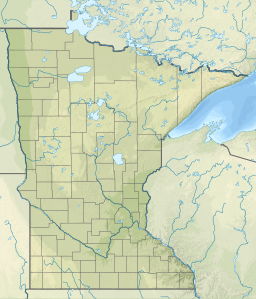Bearskin Lake (Minnesota)
| Bearskin Lake | |
|---|---|
| West Bearskin Lake, Birch Lake, Muko-waiani | |
| Location | Cook County, Minnesota |
| Group | Boundary Waters Canoe Area |
| Coordinates | 48°03′58″N 90°25′36″W / 48.066°N 90.426765°W |
| Type | oligotrophic, glacial |
| Basin countries | United States |
| Surface area | 493 acres (200 ha) |
| Average depth | 31 ft (9.4 m) |
| Max. depth | 78 ft (24 m) |
| Residence time | 17 years |
Bearskin Lake is an oligotrophic glacial lake near the Boundary Waters Canoe Area (BWCA) in Minnesota, United States. The name Bearskin Lake is an English translation of the Ojibwe-language name Muko-waiani.[1] Bearskin Lake is a source of control sediment for US federal sediment toxicity studies. Bearskin Lake is home to Camp Menogyn, a YMCA camp only accessible by boat.[citation needed]
Sediments and scientific significance[edit]
Due to the cleanliness of the lake and the physical attributes of its sediment, Bearskin Lake sediment is ideal for sediment toxicity testing.[2] Bearskin Lake sediment is used as a control sediment in the federal government's toxicity tests and was used to develop the US EPA's toxicity testing methods.[2]
See also[edit]
Further reading[edit]
- US EPA. 2000. Methods for Measuring the Toxicity and Bioaccumulation of Sediment-associated Contaminants with Freshwater Invertebrates Second Edition.[2]
- Kemble, N.E., C.G. Ingersoll, and J.L. Kunz. 2001. Evaluation of Toxicity of Sediment Samples Collected from Santa Ana National Wildlife Refuge, Texas. United States Geological Survey.[3]
- Bechtel Jacobs Company LLC. 1998. Biota Sediment Accumulation Factors for Invertebrates: Review and Recommendations for the Oak Ridge Reservation U.S. Department of Energy.[4]
- Mierzykowski, S.E., C.G. Ingersoll, and K.C. Carr. 1997 U.S. Fish and Wildlife Service New England Field Office Special Project Report: FY97-MEFO-1-EC Toxicity Tests and Sediment Chemistry at Site 9 (Neptune Drive Disposal Site).[5]
- National Oceanic and Atmospheric Administration. 1996. Bioavailability of Sediment-Associated Toxic Organic Contaminants.[6]
References[edit]
- ^ Warren Upham (1920). Minnesota Geographic Names: Their Origin and Historic Significance. Minnesota Historical Society. p. 142.
- ^ a b c EPA, OEI, OIAA, US. "Water Topics - US EPA" (PDF). US EPA.
{{cite web}}: CS1 maint: multiple names: authors list (link) - ^ http://www.cerc.usgs.gov/pubs/sedtox/santaanareport.pdf [bare URL PDF]
- ^ http://rais.ornl.gov/homepage/bjcor-112a1.pdf[permanent dead link]
- ^ "EC Reports". Archived from the original on 2008-10-11. Retrieved 2010-01-04.
- ^ Research, US Department of Commerce, NOAA, Great Lakes Environmental Research Laboratory, Cooperative Institute for Limnology and Ecosystems. "Task Report". www.glerl.noaa.gov.
{{cite web}}: CS1 maint: multiple names: authors list (link)

